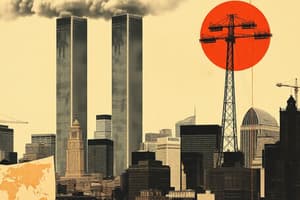Podcast
Questions and Answers
What date did the coordinated terrorist attacks occur?
What date did the coordinated terrorist attacks occur?
September 11, 2001
How many terrorists were involved in the 9/11 attacks?
How many terrorists were involved in the 9/11 attacks?
19
Which flights were involved in the attacks on the World Trade Center?
Which flights were involved in the attacks on the World Trade Center?
- American Airlines Flight 11 (correct)
- United Airlines Flight 175 (correct)
- American Airlines Flight 77
- United Airlines Flight 93
Where did United Airlines Flight 93 crash?
Where did United Airlines Flight 93 crash?
What was the approximate number of casualties from the 9/11 attacks?
What was the approximate number of casualties from the 9/11 attacks?
Al-Qaeda's grievances included U.S. foreign policy in the Middle East.
Al-Qaeda's grievances included U.S. foreign policy in the Middle East.
What agency was established by President George W. Bush shortly after the 9/11 attacks?
What agency was established by President George W. Bush shortly after the 9/11 attacks?
The USA PATRIOT Act was enacted in October 2000.
The USA PATRIOT Act was enacted in October 2000.
The Department of _______ was introduced in 2003 to manage national security and emergency response.
The Department of _______ was introduced in 2003 to manage national security and emergency response.
What major legislation expanded law enforcement's surveillance powers after the attacks?
What major legislation expanded law enforcement's surveillance powers after the attacks?
Flashcards are hidden until you start studying
Study Notes
9/11/2001 Study Notes
Terrorism
- Date and Events: September 11, 2001; coordinated terrorist attacks.
- Perpetrators: 19 terrorists from the extremist group al-Qaeda.
- Attacks:
- World Trade Center: Two planes (American Airlines Flight 11 and United Airlines Flight 175) crashed into the North and South Towers, causing their collapse.
- Pentagon: American Airlines Flight 77 crashed into the Pentagon, the headquarters of the U.S. Department of Defense.
- Flight 93: United Airlines Flight 93 was hijacked but crashed into a field in Pennsylvania after passengers attempted to overcome the hijackers, preventing an attack on a target in Washington, D.C.
- Casualties: Approximately 3,000 people killed, including civilians and first responders; thousands more injured.
- Motivation: Al-Qaeda's grievances included U.S. foreign policy in the Middle East, support for Israel, and presence of U.S. troops in Saudi Arabia.
Emergency Response
- Immediate Response:
- First responders included police, firefighters, and EMTs, who rushed to the scenes of the attacks.
- Evacuations of buildings and surrounding areas were conducted, with emergency services coordinating rescue efforts.
- Challenges:
- Communication issues among various agencies hindered response efforts.
- The collapse of the towers complicated rescue operations, trapping many first responders.
- Federal Response:
- President George W. Bush established the Office of Homeland Security within weeks of the attacks.
- The Federal Emergency Management Agency (FEMA) coordinated recovery and cleanup efforts.
- Legislation:
- The USA PATRIOT Act was enacted in October 2001, expanding law enforcement's surveillance and investigative powers.
- Long-term Impact:
- Enhanced security measures were implemented in airports and public spaces.
- Introduction of the Department of Homeland Security in 2003 to manage national security and emergency response.
Terrorism
- Date of Attacks: September 11, 2001; marked by a series of coordinated terrorist attacks.
- Perpetrators: 19 members of al-Qaeda, an extremist jihadist group.
- Major Attacks:
- World Trade Center: American Airlines Flight 11 and United Airlines Flight 175 crashed into the North and South Towers, which subsequently collapsed.
- Pentagon: American Airlines Flight 77 impacted the Pentagon, the U.S. Department of Defense's headquarters.
- Flight 93: Hijacked United Airlines Flight 93 crashed in Pennsylvania due to passenger resistance; it likely aimed at a target in Washington, D.C.
- Casualties: Roughly 3,000 people lost their lives, including many civilians and first responders; many others suffered injuries.
- Motivations Behind Attacks: Al-Qaeda opposed U.S. foreign policies, particularly concerning the Middle East, backing Israel, and the presence of U.S. troops in Saudi Arabia.
Emergency Response
- Immediate Action: Emergency personnel, including police, firefighters, and EMTs, urgently responded to the attacks.
- Evacuations: Coordination among emergency services led to the organized evacuation of buildings and surrounding areas.
- Response Challenges:
- Communication lapses among federal, state, and local agencies obstructed effective rescue operations.
- The collapsing towers created hazardous conditions, trapping many first responders.
- Federal Actions:
- President George W. Bush initiated the Office of Homeland Security shortly after the events.
- FEMA played a crucial role in managing recovery and clean-up operations post-attacks.
- Legislation:
- The USA PATRIOT Act, enacted in October 2001, broadened surveillance and investigative powers for law enforcement agencies.
- Long-term Changes:
- Security protocols were significantly heightened at airports and public venues.
- The Department of Homeland Security was established in 2003 to oversee national security and emergency management responses.
Studying That Suits You
Use AI to generate personalized quizzes and flashcards to suit your learning preferences.




